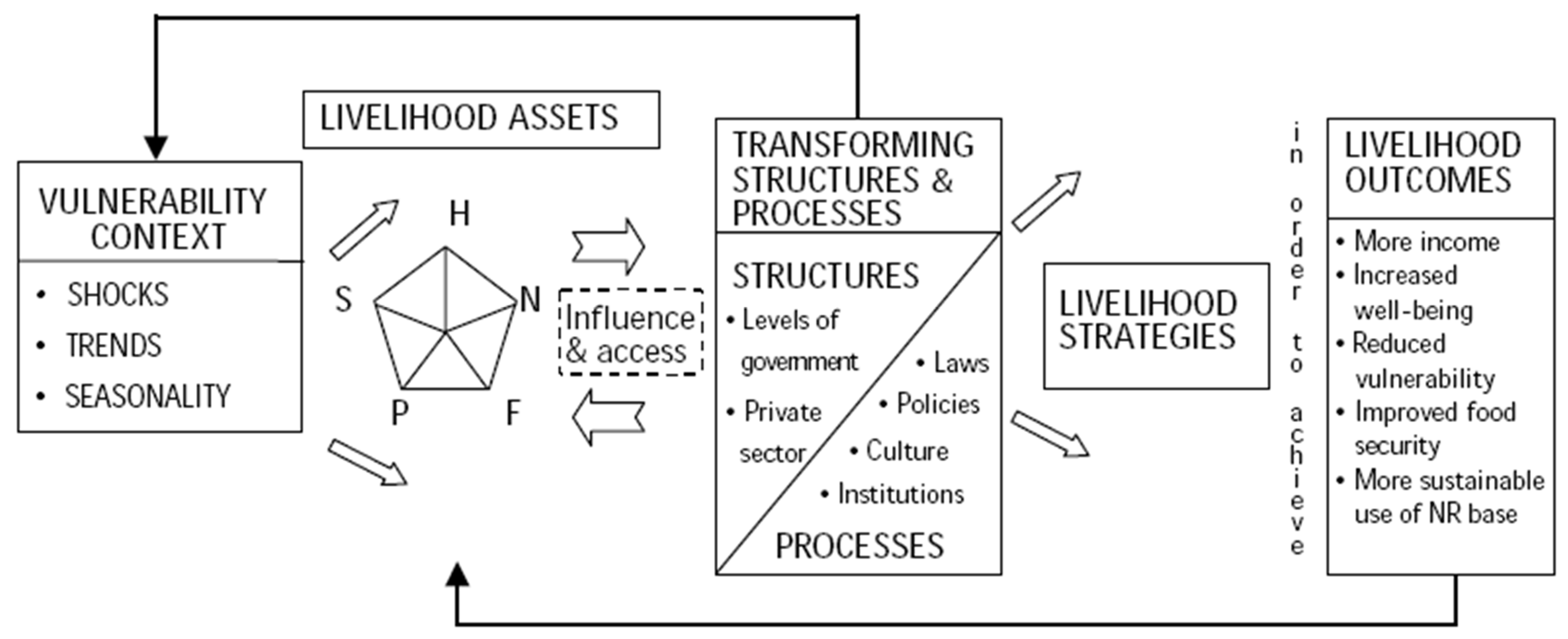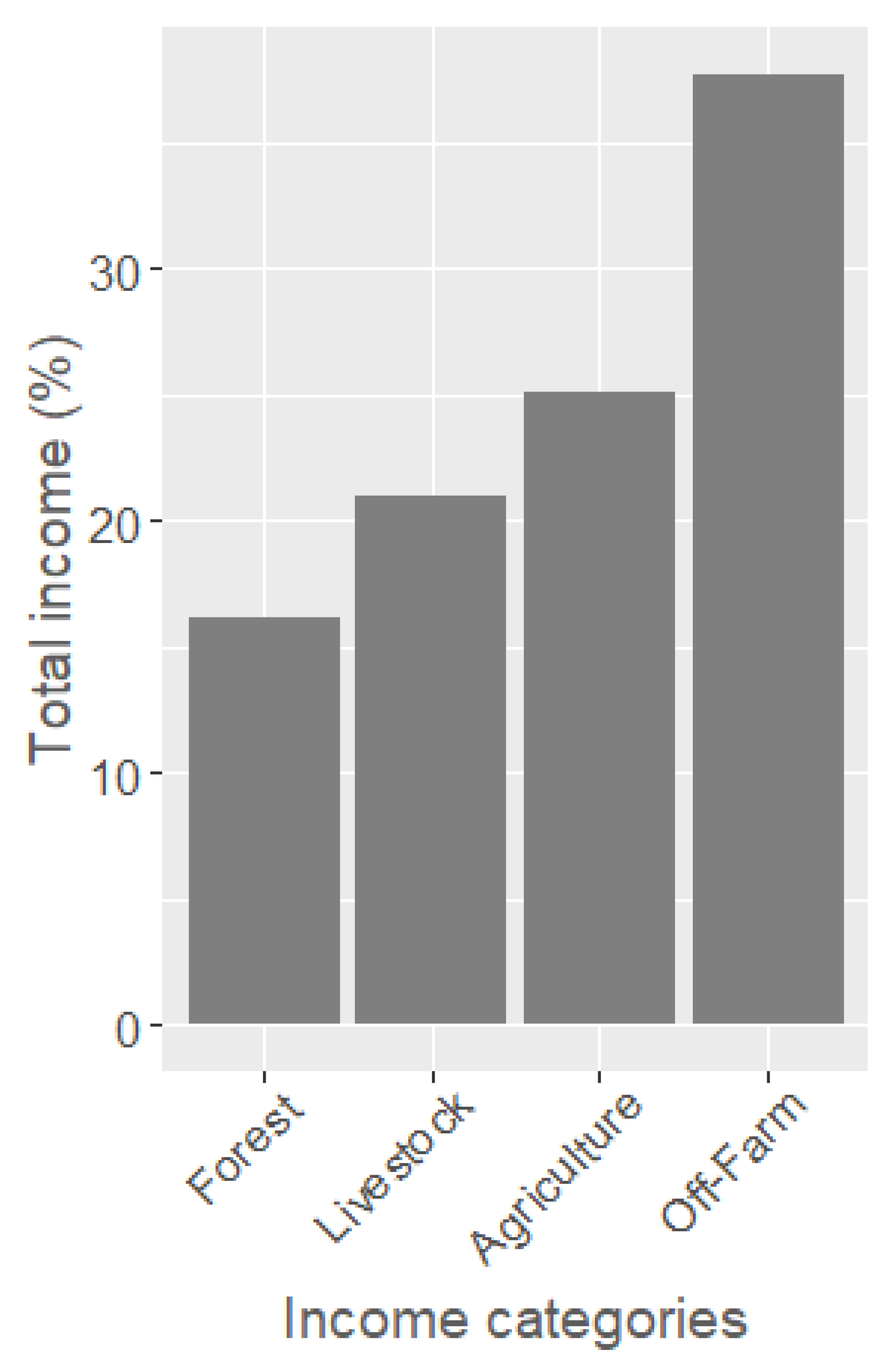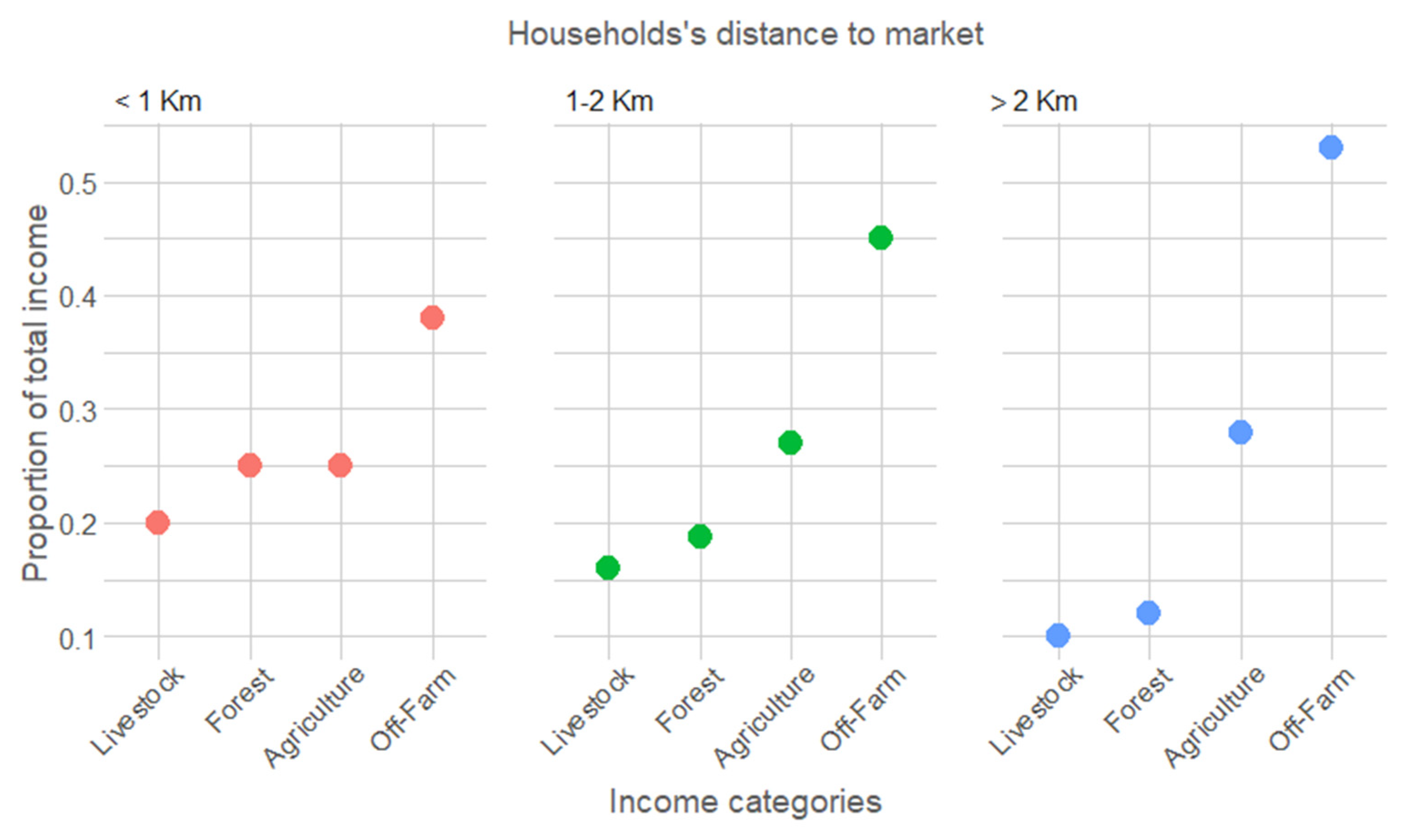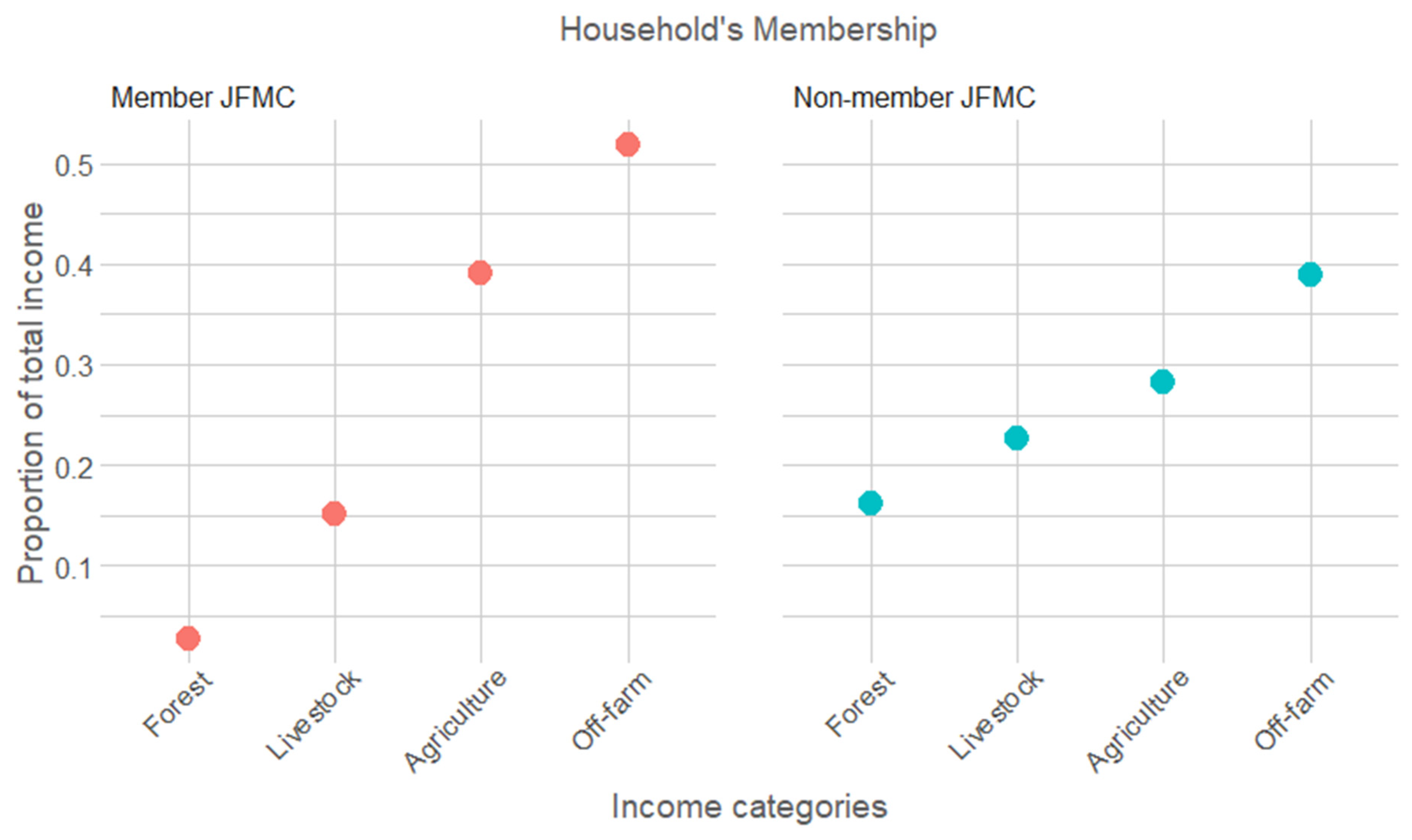Why Do Households Depend on the Forest for Income? Analysis of Factors Influencing Households’ Decision-Making Behaviors
Abstract
:1. Introduction
Theoretical Framework
2. Data and Methods
2.1. Study Area Profile
2.2. Data Collection
2.3. Income Calculation
2.4. Variables Used and Hypothesis
2.5. Statistical Analysis
3. Results
3.1. Sample Overview and Descriptive Statistics
3.2. Household Income Sources and Their Relative Contribution
3.3. Regression Analysis
4. Discussion
4.1. Household Size and Forest Income
4.2. Off-Farm Employment and Forest Income
4.3. Households’ Assets Status and Forest Income
4.4. Households’ Off-Farm and Forest Income
4.5. Household Distance to the Market and Forest Income
4.6. Household Membership to JFMCs and Forest Income
5. Conclusions and Recommendations
Author Contributions
Funding
Conflicts of Interest
References
- Lowore, J.; Meaton, J.; Wood, A. African forest honey: An overlooked NTFP with potential to support livelihoods and forests. Environ. Manag. 2018, 62, 15–28. [Google Scholar] [CrossRef] [Green Version]
- Zeb, A.; Hamann, A.; Armstrong, G.W.; Acuna-Castellanos, D. Identifying local actors of deforestation and forest degradation in the Kalasha valleys of Pakistan. For. Policy Econ. 2019, 104, 56–64. [Google Scholar] [CrossRef]
- Angelsen, A.; Jagger, P.; Babigumira, R.; Belcher, B.; Hogarth, N.J.; Bauch, S.; Wunder, S. Environmental income and rural livelihoods: A global-comparative analysis. World Dev. 2014, 64, S12–S28. [Google Scholar] [CrossRef] [PubMed] [Green Version]
- Wunder, S.; Angelsen, A.; Belcher, B. Forests, livelihoods, and conservation: Broadening the empirical base. World Dev. 2014, 64, S1–S11. [Google Scholar] [CrossRef] [Green Version]
- Ali, A. Forest-based livelihoods, income, and poverty: Empirical evidence from the Himalayan region of rural Pakistan. J. Rural. Stud. 2018, 57, 44–54. [Google Scholar] [CrossRef]
- Ahammad, R.; Stacey, N.; Sunderland, T.C. Use and perceived importance of forest ecosystem services in rural livelihoods of Chittagong Hill Tracts, Bangladesh. Ecosyst. Serv. 2019, 35, 87–98. [Google Scholar] [CrossRef]
- Schreckenberg, K.; Poudyal, M.; Mace, G. Ecosystem Services and Poverty Alleviation: Trade-offs and Governance; Taylor & Francis: Boca Raton, FL, USA, 2018; p. 352. [Google Scholar]
- Sandhu, H.; Sandhu, S. Poverty, development, and Himalayan ecosystems. Ambio 2015, 44, 297–307. [Google Scholar] [CrossRef] [PubMed] [Green Version]
- Adam, Y.O.; Pretzsch, J.; Pettenella, D. Contribution of non-timber forest products livelihood strategies to rural development in drylands of Sudan: Potentials and failures. Agric. Syst. 2013, 177, 90–97. [Google Scholar] [CrossRef]
- Schaafsma, M.; Morse-Jones, S.; Posen, P.; Swetnam, R.D.; Balmford, A.; Bateman, I.J.; Burgess, N.B.; Chamshama, S.A.O.; Fisher, B.; Freeman, T.; et al. The importance of local forest benefits: Economic valuation of Non-Timber Forest Products in the Eastern Arc Mountains in Tanzania. Glob. Environ. Chang. 2014, 24, 295–305. [Google Scholar] [CrossRef]
- Rasmussen, L.V.; Watkins, C.; Agrawal, A. Forest contributions to livelihoods in changing agriculture-forest landscapes. For. Policy Econ. 2017, 84, 1–8. [Google Scholar] [CrossRef]
- Amare, D.; Mekuria, W.; Wondie, M.; Teketay, D.; Eshete, A.; Darr, D. Wood extraction among the households of Zege Peninsula, Northern Ethiopia. Ecol. Econ. 2017, 142, 177–184. [Google Scholar] [CrossRef]
- Chopra, K. The valuation and pricing of non-timber forest products: Conceptual issues and a case study from India. In Environmental Sustainability. Practical Global Applications; Taylor & Francis: Boca Raton, FL, USA, 2019; pp. 114–146. [Google Scholar]
- Uberhuaga, P.; Smith-Hall, C.; Helles, F. Forest income and dependency in lowland Bolivia. Environ. Dev. Sustain. 2012, 14, 3–23. [Google Scholar] [CrossRef]
- Aung, P.S.; Adam, Y.O.; Pretzsch, J.; Peters, R. Distribution of forest income among rural households: A case study from Natma Taung national park, Myanmar. For. Trees Livelihoods 2015, 24, 190–201. [Google Scholar] [CrossRef]
- Garekae, H.; Thakadu, O.T.; Lepetu, J. Socio-economic factors influencing household forest dependency in Chobe enclave, Botswana. Ecol. Process. 2017, 6, 40. [Google Scholar] [CrossRef]
- Hussain, J.; Zhou, K.; Akbar, M.; Zafar khan, M.; Raza, G.; Ali, S.; Hussain, A.; Abbas, Q.; Khan, G.; Khan, M.; et al. Dependence of rural livelihoods on forest resources in Naltar Valley, a dry temperate mountainous region, Pakistan. Glob. Ecol. Conserv. 2019, 20, e00765. [Google Scholar] [CrossRef]
- Ullah, A.; Sam, A.S.; Sathyan, A.R.; Mahmood, N.; Zeb, A.; Kächele, H. Role of Local Communities in Forest Landscape Restoration: Key Lessons from the Billion Trees Afforestation Project, Pakistan. Sci. Total Environ. 2021, 772, 145613. [Google Scholar] [CrossRef] [PubMed]
- Zeb, A.; Armstrong, G.W.; Hamann, A. Forest conversion by the indigenous Kalasha of Pakistan: A household level analysis of socioeconomic drivers. Glob. Environ. Chang. 2019, 59, 102004. [Google Scholar] [CrossRef]
- Parvathi, P.; Nguyen, T.T. Is environmental income reporting evasive in household surveys? Evidence from rural poor in Laos. Ecol. Econ. 2018, 143, 218–226. [Google Scholar] [CrossRef]
- Damania, R.; Joshi, A.; Russ, J. India’s forests–Stepping stone or millstone for the poor? World Dev. 2020, 125, 104451. [Google Scholar] [CrossRef]
- Zeb, A. Spatial and temporal trends of forest cover as a response to policy interventions in the district Chitral, Pakistan. Appl. Geogr. 2019, 102, 39–46. [Google Scholar] [CrossRef]
- Hasan, L. An anatomy of state failures in forest management in Pakistan. Pak. Dev. Rev. 2007, 46, 1189–1203. [Google Scholar] [CrossRef] [Green Version]
- Irland, L.C. State failure, corruption, and warfare: Challenges for forest policy. J. Sustain. For. 2008, 27, 189–223. [Google Scholar] [CrossRef]
- Tumusiime, D.M.; Byakagaba, P.; Tweheyo, M. Policy and Institutional Drivers of Deforestation. Environ. Policy Law 2018, 48, 137–144. [Google Scholar] [CrossRef]
- Brandt, J.S.; Allendorf, T.; Radeloff, V.; Brooks, J. Brooks Effects of National Forest-management Regimes on Unprotected Forests of the Himalaya. Conserv. Biol. 2017, 31, 1271–1282. [Google Scholar] [CrossRef] [PubMed]
- Cuni-Sanchez, A.; Ngute, A.S.K.; Sonké, B.; Sainge, M.N.; Burgess, N.D.; Klein, J.A.; Marchant, R. The importance of livelihood strategy and ethnicity in forest ecosystem services’ perceptions by local communities in north-western Cameroon. Ecosyst. Serv. 2019, 40, 101000. [Google Scholar] [CrossRef]
- Robinson, B.E.; Zheng, H.; Peng, W. Disaggregating livelihood dependence on ecosystem services to inform land management. Ecosyst. Serv. 2019, 36, 100902. [Google Scholar] [CrossRef]
- Qasim, M.; Hubacek, K.; Termansen, M. Underlying and proximate driving causes of land use change in district Swat, Pakistan. Land Use Policy 2013, 34, 146–157. [Google Scholar] [CrossRef]
- Ali, J.; Benjaminsen, T.A. Fuelwood, timber and deforestation in the Himalayas. Mt. Res. Dev. 2004, 24, 312–318. [Google Scholar] [CrossRef]
- Ali, J.; Benjaminsen, T.A.; Hammad, A.A.; Dick, Ø.B. The road to deforestation: An assessment of forest loss and its causes in Basho Valley, Northern Pakistan. Glob. Environ. Chang. 2005, 15, 370–380. [Google Scholar] [CrossRef]
- Ali, T.; Ahmad, M.; Shahbaz, B.; Suleri, A. Impact of participatory forest management on vulnerability and livelihood assets of forest-dependent communities in northern Pakistan. Int. J. Sustain. Dev. World Ecol. 2007, 14, 211–223. [Google Scholar] [CrossRef]
- Shahbaz, B.; Mbeyale, G.; Haller, T. Trees, trust and the state: A comparison of participatory forest management in Pakistan and Tanzania. J. Int. Dev. J. Dev. Stud. Assoc. 2008, 20, 641–653. [Google Scholar] [CrossRef]
- Khan, S.R.; Khan, S.R. Assessing poverty–deforestation links: Evidence from Swat, Pakistan. Ecol. Econ. 2009, 68, 2607–2618. [Google Scholar] [CrossRef]
- Ellis, F.; Freeman, H.A. Rural livelihoods and poverty reduction strategies in four African countries. J. Dev. Stud. 2004, 40, 1–30. [Google Scholar] [CrossRef] [Green Version]
- Ellis, F. The determinants of rural livelihood diversification in developing countries. J. Agric. Econ. 2000, 51, 289–302. [Google Scholar] [CrossRef]
- Ellis, F. Livelihoods Approach to Migration and Poverty Reduction; Contract No: CNTR 03 4890 2003; Paper Commissioned by the Department for International Development (DFID): London, UK, 2003. [Google Scholar]
- Sayer, J.; Campbell, B.; Petheram, L.; Aldrich, M.; Perez, M.R.; Endamana, D. Assessing environment and development outcomes in conservation landscapes. Biodivers. Conserv. 2007, 16, 2677–2694. [Google Scholar] [CrossRef]
- Babigumira, R.; Angelsen, A.; Buis, M.; Bauch, S.; Sunderland, T.; Wunder, S. Forest clearing in rural livelihoods: Household-level global-comparative evidence. World Dev. 2014, 64, S67–S79. [Google Scholar] [CrossRef] [Green Version]
- De Haan, L.; Zoomers, A. Exploring the frontier of livelihoods research. Dev. Chang. 2005, 36, 27–47. [Google Scholar] [CrossRef]
- Shahbaz, B.; Ali, T.; Suleri, A.Q. Dilemmas and challenges in forest conservation and development interventions: Case of Northwest Pakistan. For. Policy Econ. 2011, 13, 473–478. [Google Scholar] [CrossRef]
- Sunderlin, W.D.; Angelsen, A.; Belcher, B.; Burgers, P.; Nasi, R.; Santoso, L.; Wunder, S. Livelihoods, forests, and conservation in developing countries: An overview. World Dev. 2005, 33, 1383–1402. [Google Scholar] [CrossRef]
- Nielsen, Ø.J.; Rayamajhi, S.; Uberhuaga, P.; Meilby, H.; Smith-Hall, C. Quantifying rural livelihood strategies in developing countries using an activity choice approach. Agric. Econ. 2013, 44, 57–71. [Google Scholar] [CrossRef]
- DfID, U.K. Sustainable Livelihoods Guidance Sheets; DFID: London, UK, 1999; p. 445. [Google Scholar]
- Qasim, M.; Hubacek, K.; Termansen, M.; Khan, A. Spatial and temporal dynamics of land use pattern in District Swat, Hindu Kush Himalayan region of Pakistan. Appl. Geogr. 2011, 31, 820–828. [Google Scholar] [CrossRef]
- Pan, W.; Carr, D.; Barbieri, A.; Bilsborrow, R.; Suchindran, C. Forest clearing in the Ecuadorian Amazon: A study of patterns over space and time. Popul. Res. Policy Rev. 2007, 26, 635–659. [Google Scholar] [CrossRef] [PubMed] [Green Version]
- Gujarati, D.N. Basic Econometrics, 4th ed.; McGraw-Hill/Irwin: New York, NY, USA, 2003. [Google Scholar]
- Vedeld, P.; Angelsen, A.; Bojö, J.; Sjaastad, E.; Berg, G.K. Forest environmental incomes and the rural poor. For. Policy Econ. 2007, 9, 869–879. [Google Scholar] [CrossRef]
- Kamanga, P.; Vedeld, P.; Sjaastad, E. Forest incomes and rural livelihoods in Chiradzulu District, Malawi. Ecol. Econ. 2009, 68, 613–624. [Google Scholar] [CrossRef]
- Tesfaye, Y.; Roos, A.; Campbell, B.; Bohlin, F. Forest income and poverty alleviation under participatory forest management in the Bale Highlands, South Ethiopia. Int. For. Rev. 2010, 12, 558–577. [Google Scholar] [CrossRef]
- Tumusiime, D.M.; Vedeld, P.; Gombya-Ssembajjwe, W. Breaking the law? Illegal livelihoods from a protected area in Uganda. For. Policy Econ. 2011, 13, 273–283. [Google Scholar] [CrossRef]
- Asfaw, A.; Lemenih, M.; Kassa, H.; Ewnetu, Z. Importance, determinants and gender dimensions of forest income in eastern highlands of Ethiopia: The case of communities around Jelo Afromontane forest. For. Policy Econ. 2013, 28, 1–7. [Google Scholar] [CrossRef]
- Dib, J.B.; Alamsyah, Z.; Qaim, M. Land-use change and income inequality in rural Indonesia. For. Policy Econ. 2018, 94, 55–66. [Google Scholar] [CrossRef]
- Vasco, C.; Bilsborrow, R.; Torres, B.; Griess, V. Agricultural land use among mestizo colonist and indigenous populations: Contrasting patterns in the Amazon. PLoS ONE 2018, 13, e0199518. [Google Scholar] [CrossRef]
- Ullah, A.; Mahmood, N.; Zeb, A.; Kächele, H. Factors Determining Farmers’ Access to and Sources of Credit: Evidence from the Rain-Fed Zone of Pakistan. Agriculture 2020, 10, 586. [Google Scholar] [CrossRef]
- Ullah, A.; Arshad, M.; Kächele, H.; Zeb, A.; Mahmood, N.; Müller, K. Socio-economic analysis of farmers facing asymmetric information in inputs markets: Evidence from the rainfed zone of Pakistan. Technol. Soc. 2020, 63, 101405. [Google Scholar] [CrossRef]
- Lax, J.; Köthke, M. Livelihood strategies and forest product utilisation of rural households in Nepal. Small-Scale For. 2017, 16, 505–520. [Google Scholar] [CrossRef]
- Härtl, F.H.; Paul, C.; Knoke, T. Cropping systems are homogenized by off-farm income–Empirical evidence from small-scale farming systems in dry forests of southern Ecuador. Land Use Policy 2019, 82, 204–219. [Google Scholar] [CrossRef]
- Horn, C.M.; Gilmore, M.P.; Endress, B.A. Ecological and socio-economic factors influencing aguaje (Mauritia flexuosa) resource management in two indigenous communities in the Peruvian Amazon. For. Ecol. Manag. 2012, 267, 93–103. [Google Scholar] [CrossRef]
- Melaku, E.; Ewnetu, Z.; Teketay, D. Non-timber forest products and household incomes in Bonga forest area, southwestern Ethiopia. J. For. Res. 2014, 25, 215–223. [Google Scholar] [CrossRef]
- Ullah, A.; Arshad, M.; Kächele, H.; Khan, A.; Mahmood, N.; Müller, K. Information asymmetry, input markets, adoption of innovations and agricultural land use in Khyber Pakhtunkhwa, Pakistan. Land Use Policy 2020, 90, 104261. [Google Scholar] [CrossRef]
- Angelsen, A.; Kaimowitz, D. Rethinking the causes of deforestation: Lessons from economic models. World Bank Res. Obs. 1999, 14, 73–98. [Google Scholar] [CrossRef]
- Basnet, S.; Sharma, P.; Timalsina, N.; Khaine, I. Community Based Management for Forest Conservation and Livelihood Improvement: A Comparative Analysis from Forests in Myanmar. J. For. Livelihood 2018, 17, 16–33. [Google Scholar]
- Finley-Brook, M. Indigenous land tenure insecurity fosters illegal logging in Nicaragua. Int. For. 2007, 9, 850–864. [Google Scholar] [CrossRef]
- Robinson, B.E.; Holland, M.B.; Naughton-Treves, L. Does secure land tenure save forests? A meta-analysis of the relationship between land tenure and tropical deforestation. Glob. Environ. Chang. 2013, 29, 281–293. [Google Scholar] [CrossRef]





| Sub-Divisions | Villages | Total Households | Sampled Households (%) |
|---|---|---|---|
| Behrain | Aryanay | 6225 | 6 |
| Laykot | 3433 | 3 | |
| Chail | 6052 | 6 | |
| Torwal | 2848 | 3 | |
| Mankiyal | 5155 | 5 | |
| Tirat | 21,870 | 21 | |
| K. Khela | Jari/Pia | 12,593 | 12 |
| khair Abad | 2002 | 2 | |
| Miandam | 15,095 | 14 | |
| Sainay | 3141 | 3 | |
| Jokhtai | 7180 | 7 | |
| Matta | Lalkoo | 5855 | 6 |
| Landighari | 6616 | 6 | |
| Sakhra | 13,456 | 13 | |
| Wainy | 4858 | 5 | |
| Kabal | Delay | 1625 | 2 |
| Dadahara | 6720 | 6 | |
| Dagay | 6506 | 6 | |
| Akhonkaly | 2882 | 3 | |
| Barikot | Aboha | 13256 | 13 |
| Shamozi | 7987 | 8 | |
| Total | 155,355 | 150 |
| Variables | Definition and Unit of Measurement | Expected Sign |
|---|---|---|
| Dependent Variables | ||
| Forest income (Yes/no) | Whether or not households receive income from the forest | |
| Forest Income (Rs) | How much income households receive from the forest | |
| Independent variables | ||
| Demographic variables | ||
| Household size | Total number of individuals in the household | +/− |
| Male/female ratio | Male/female ratio in the household | − |
| Family type | 1. Nuclear | + |
| 2. Joint | +/− | |
| Age of head | Household age in years (years) | − |
| Education of head | Years of schooling (years) | - |
| Off-farm employment | Number working in off-farm sector (people) | − |
| Social variables | ||
| JFMC (membership) | Membership of forest organization (0/1) | − |
| Ethnicity | Membership of large ethnic group (0/1) | +/− |
| Physical variables | ||
| Physical assets | Value of household implements and other | |
| large items in Pakistan rupees (PKR) | − | |
| Distance to market | Access of households to the market | + |
| Land holding | Agricultural land owned by the household | − |
| Livestock value | Estimated value of livestock in PKR | + |
| Economic and financial variables | ||
| Income agriculture | Worth (in Pakistani currency) | − |
| Income Livestock | Worth (in Pakistani currency) | +/− |
| Income off-farm | Worth (in Pakistani currency) | − |
| Livestock value | Worth (in Pakistani currency) | +/− |
| Variables | Summary statistics | |
|---|---|---|
| Unit | Median (IQR) or Count (%) | |
| Household’s distance | ||
| Household member JFMC | Households (%) | 14 |
| Households dist. Forest < 1 | Households (Km) | 43.3 |
| Households dist. Forest < 2 (cr. 2) | Households (Km) | 53.3 |
| Households dist. Forest > 2 (cr. 2) | Households (Km) | 3.3 |
| Household’s forest dependency | ||
| Households with forest income | Households (%) | 66 |
| Households graze livestock/fodder | Households (%) | 66 |
| Households collect medicinal plant | Households (%) | 28.6 |
| Households extract fuel wood | Households (%) | 100 |
| Household demographic | ||
| Household headcount | Headcount (IQR) | 12 |
| Male/female ratio | Ratio | 1:1 |
| Age of head | Years (IQR) | 47 |
| Education | Years (IQR) | 0 (14) |
| Employed off-farm | Headcount (IQR) | 2 |
| Household Socio-economic | ||
| Ethnicity (Gujar) | Households (%) | 71.3 |
| Physical assets | PKR (IQR) | 63220 |
| Livestock value | PKR (IQR) | 234100 |
| Cropland area | Acres | 2.059 |
| Village level characteristics | ||
| Forest area | Percentage (%) | 32.83 |
| Agriculture area | Percentage (%) | 25.29 |
| Variables | Logit Model | Tobit Model | ||||
|---|---|---|---|---|---|---|
| Parameter | Standard | Odds | Parameter | Standard | Odd | |
| Estimate | Error | Ratio | Estimate | Error | Ratio | |
| Intercept | 0.245 | 8.652 | ||||
| Distance from market (1–2 km) | 0.789 | 0.774 | 2.20 | −0.003 | (0.001) | 0.19 ** |
| Distance from market (>2 km) | −1.595 | 2.226 | 0.20 | −0.0001 | (0.004) | 0.34 *** |
| JFMC (membership) | −1.776 | 1.134 | 0.16 | −0.007 | (0.001) | 0.10 ** |
| Member employed off-farm | −1.314 | 0.448 | 3.71 ** | −0.001 | (0.070) | 1.85 ** |
| Ethnicity (Khan tribe) | 0.0155 | 1.035 | 1.01 | 0.038 | (0.001) | 0.39 |
| Family type (joint) | −0.366 | 0.887 | 0.69 | 0.001 | (0.001) | 1.04 |
| Household size | 0.855 | 0.2511 | 0.42 *** | 0.001 | (0.040) | 1.35 |
| Total agriculture land (acers) | 0.194 | 0.232 | 1.21 | 0.444 | (0.044) | 1.01 |
| Physical assets (Rs) | −0.002 | 0.007 | 0.89 *** | −0.469 | (0.092) | 0.62 *** |
| Livestock value (Rs) | −0.0007 | 0.0006 | 1.09 | −0.002 | (0.004) | 0.99 |
| Agriculture income (Rs) | 0.001 | 0.006 | 1.00 | 0.001 | (0.010) | 1.00 |
| Off-farm income (Rs) | −0.0007 | 0.0007 | 1.26 *** | −0.067 | (0.009) | 0.93 *** |
| Livestock income (Rs) | −0.0004 | 0.0004 | 0.85 | −0.005 | (0.007) | 0.99 |
| Fuel extraction (kg) | 0.002 | 0.0009 | 1.02 | 0.112 | (0.125) | 0.00 |
| Household education | 0.049 | 0.083 | 1.05 | −0.102 | (0.014) | 0.00 |
| Household age | −0.037 | 0.032 | 0.96 | −0.324 | (0.472) | 0.10 |
| Sub-Division | Annual Income (‘000 pkr) | Percentage of RESPONDENTS | Contribution to Household Income (%) | |||
|---|---|---|---|---|---|---|
| Crops | Livestock | Forest | Off-Farm | |||
| Behrain | <250 | 37.5 | 25.06 | 22.08 | 19.27 | 33.59 |
| 250–350 | 35 | 27.8 | 24.3 | 17.7 | 30.2 | |
| 350–450 | 20 | 29.8 | 21.6 | 12.4 | 36.2 | |
| >450 | 7.5 | 35.54 | 19.72 | 8.73 | 36.01 | |
| K. Khela | <250 | 13.8 | 26.3 | 21.7 | 18.9 | 33.1 |
| 250–350 | 41.6 | 29.6 | 23.1 | 14.4 | 32.9 | |
| 350–450 | 16.6 | 27.7 | 25.6 | 10.6 | 36.1 | |
| >450 | 36.8 | 30.6 | 24.9 | 7.4 | 37.1 | |
| Kabal | <250 | 24 | 20.3 | 23.7 | 19.1 | 36.9 |
| 250–350 | 16 | 22.0 | 26.2 | 13.1 | 38.7 | |
| 350–450 | 20 | 25.5 | 25.3 | 10.2 | 39.0 | |
| >450 | 40 | 27.3 | 25.7 | 6.1 | 40.9 | |
| Matta | <250 | 44.82 | 30.3 | 21.5 | 17.3 | 30.9 |
| 250–350 | 24.13 | 28.5 | 19.4 | 12.2 | 39.9 | |
| 350–450 | 20.68 | 25.1 | 22.4 | 9.5 | 43.0 | |
| >450 | 10.34 | 26.7 | 20.2 | 4.4 | 48.7 | |
| Barikot | <250 | 40 | 29.6 | 23.3 | 14.5 | 32.6 |
| 250–350 | 30 | 31.2 | 22.7 | 10.3 | 35.8 | |
| 350–450 | 20 | 28.9 | 19.1 | 6.3 | 45.7 | |
| >450 | 10 | 32.5 | 16.8 | 3.9 | 46.8 | |
Publisher’s Note: MDPI stays neutral with regard to jurisdictional claims in published maps and institutional affiliations. |
© 2021 by the authors. Licensee MDPI, Basel, Switzerland. This article is an open access article distributed under the terms and conditions of the Creative Commons Attribution (CC BY) license (https://creativecommons.org/licenses/by/4.0/).
Share and Cite
Biland, M.; Zeb, A.; Ullah, A.; Kaechele, H. Why Do Households Depend on the Forest for Income? Analysis of Factors Influencing Households’ Decision-Making Behaviors. Sustainability 2021, 13, 9419. https://doi.org/10.3390/su13169419
Biland M, Zeb A, Ullah A, Kaechele H. Why Do Households Depend on the Forest for Income? Analysis of Factors Influencing Households’ Decision-Making Behaviors. Sustainability. 2021; 13(16):9419. https://doi.org/10.3390/su13169419
Chicago/Turabian StyleBiland, Mazhar, Alam Zeb, Ayat Ullah, and Harald Kaechele. 2021. "Why Do Households Depend on the Forest for Income? Analysis of Factors Influencing Households’ Decision-Making Behaviors" Sustainability 13, no. 16: 9419. https://doi.org/10.3390/su13169419
APA StyleBiland, M., Zeb, A., Ullah, A., & Kaechele, H. (2021). Why Do Households Depend on the Forest for Income? Analysis of Factors Influencing Households’ Decision-Making Behaviors. Sustainability, 13(16), 9419. https://doi.org/10.3390/su13169419





